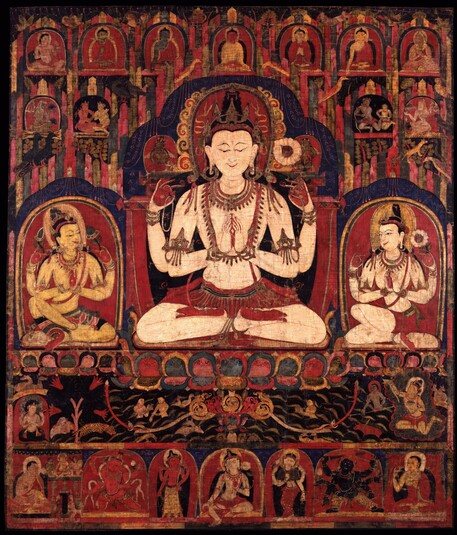
Item: Avalokiteshvara (Bodhisattva & Buddhist Deity) - Chaturbhuja (4 hands)
| Origin Location | Central Tibet |
|---|---|
| Date Range | 1100 - 1199 |
| Lineages | Buddhist |
| Size | 86.36x74.63cm (34x29.38in) |
| Material | Ground Mineral Pigment on Cotton |
| Collection | John and Berthe Ford |
Alternate Names: Lokeshvara Avalokita Lokanata Lokanatha Mahakarunika
Classification: Deity
Appearance: Peaceful
Gender: Male
Avalokiteshvara, Chaturbhuja (Tibetan: chen re zi, chag shi pa. English: the All Seeing Lord with Four Hands).
Learn how to read this painting: Analysis | Interpretation | Identification
The central figure is Avalokiteshvara, white in colour, with four hands. At his right is the male attendant Manidharin, yellow in colour, and at the left, the female, Shadakshari, white in colour. Both are similar to the Lord in colour, ornaments and appearance. Sometimes they are referred to as the son and daughter of Avalokiteshvara. The iconography for the two attendant figures is not consistent nor is it necessarily fixed in one authoritative orthodox text. They can appear either white or yellow in colour and have either two arms or four. Often Manidharin appears with two arms and Shadakshari with four.
"As the nature of all buddhas, Avalokiteshvara, in colour like stainless conch and crystal, very resplendent, smiling, peaceful and radiant. With four hands the first are folded at the heart, the lower hold a crystal mala and jeweled lotus, two beautiful feet seated in vajra posture, adorned with many attractive silks and jewels, beautified with dark blue hair in tufts [some] loose. On the crown of the head, the wisdom of all buddhas, is the Lord, source of all refuge gathered as one, in essence the Guru in the aspect of Amitabha [Buddha], in the manner of the Lord of the Family, seated happily." (Ngorchen Konchog Lhundrub 1497-1557).
At the top center is Amitabha Buddha, red in colour, with Akshobhya and Amoghasiddhi Buddhas on the left and Vairochana and Ratnasambhava Buddhas on the right. These are the Five Symbolic Buddhas of the Tantric classification systems of Yoga and Anuttarayoga Tantra. At the ends of the top register are two Indian mahasiddha figures. On the register below are four more Indian siddhas, two on each side, for a total of six. All of this is set against a backdrop of idealized and variously coloured mountains, wild birds, and animals of all kinds.
The three central figures all sit on lotus flower thrones rising above decorative stems surrounded by animals and four small human-like figures. At the left side is a naga figure, white in colour, with four arms and a hood of cobra snake heads. On the right side is a devi figure flying in the air and presenting offerings in both hands.
At the bottom center is Avalokiteshvara with one face and two hands as the central figure in the group known as the Five Deity Amoghapasha. On the left is red Amoghapasha with four arms followed by red Hayagriva, wrathful, with four arms. On the right side is white Bhrikuti with two arms and blue-black Ekajati, wrathful, with eight arms. At the far left and right are seated monastic figures. The figure on the left is seated in front of a shrine and the small figure of Yellow Jambhala, a wealth deity, sits slightly above.
Avalokiteshvara is the patron bodhisattva of Tibet and included in all Buddhist traditions as both a bodhisattva and meditational deity. There are numerous New (Sarma) lineages and varying forms of practice that span all four tantric classifications as well as uncounted old oral traditions (Kama) and Treasure (Terma) traditions from the Nyingma School of Tibetan Buddhism.
There are many different sacred Buddhist traditions that depict the various forms of Avalokiteshvara. Most of these traditions only have an initiation ritual and at best a very short daily ritual practice (sadhana). Preserved in the Tibetan Buddhist tradition there are seven principal traditions that contain extensive teachings on the practice of Avalokiteshvara. The first of these is:
1] King's Tradition (gyal lug) of Tri Songtsen Gampo,
[2] Bhikshuni Shri Tradition (gelongma palmo lug) of the Kashmiri nun, Gelongma Palmo [top right corner],
[3] Kyergangpa Tradition (gyergang lug) of the Shangpa Kagyu,
[4] Tsembupa Tradition (tsembupa lug) of the Sakyas,
[5] Dagyal Tradition (dagyal lug) of the Nyingma Treasure (terma) tradition,
[6] Maitri Yogin,
[7] Karma Chagme Tradition (karma chagme lug) joining the philosophical systems of Mahamudra and Dzogchen with compassion.
Jeff Watt 2-2007
Numbered & Greyscale:
1. Chaturbhuja Avalokiteshvara
2. Manidharin
3. Shadakshari
4. Vairochana Buddha
5. Akshobhya Buddha
6. Amitabha Buddha
7. Amoghasiddhi Buddha
8. Ratnasambhava Buddha
9. Indian Siddha
10. Monastic Figure
11. Indian Siddha
12. Indian Siddha
13. Indian Siddha
14. Indian Siddha
15. Khasarpani Avalokiteshvara (Five Deity)
16. Amoghapasha
17. Bhrikuti
18. Hayagriva
19. Ekajati
20. Donor Figure
21. Donor Figure
Buddhist Deity: Avalokiteshvara, Chaturbhuja Art History
Buddhist Deity: Avalokiteshvara Masterworks (Painting)
Buddhist Deity: Avalokiteshvara Main Page
Buddhist Deity: Avalokiteshvara, Four Hands (Masterworks)
Buddhist Deity: Lokeshvara, Chaturbhuja (Best Examples, Paintings)
Buddhist Deity: Avalokiteshvara, Chaturbhuja (Early Works)
Subject: Art & Tantric Symbolism
Collection of John and Berthe Ford
Buddhist Deity: Avalokiteshvara, Chaturbhuja - Four Hands - Main Page
Painting Style: Indian (11th to 13th century)
Buddhist Deity: Avalokiteshvara, Chaturbhuja (Three Deity)
Buddhist Deity: Avalokiteshvara, Four Hands (Painting Masterworks)
Buddhist Deity: Avalokita (Chaturbhuja Painting Masterworks Description)
Buddhist Deity: Avalokita, Chaturbhuja, Three Iconographic Topics
Buddhist Deity: Avalokiteshvara, Chaturbhuja (Without a Krishnasara)



